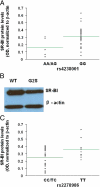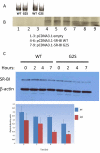Scavenger receptor class B type I protein as an independent predictor of high-density lipoprotein cholesterol levels in subjects with hyperalphalipoproteinemia
- PMID: 19158204
- PMCID: PMC2682469
- DOI: 10.1210/jc.2008-1223
Scavenger receptor class B type I protein as an independent predictor of high-density lipoprotein cholesterol levels in subjects with hyperalphalipoproteinemia
Abstract
Context: In mice, scavenger receptor class B, type I (SR-BI) receptor protein deficiency is associated with elevated high-density lipoprotein (HDL)-cholesterol (HDL-C) levels.
Objective: Our objective was to determine the relationship between SR-BI protein and HDL-C levels in humans.
Design: This was a prospective study of adults with hyperalphalipoproteinemia. Fasting blood was obtained for lipid and lipoprotein measurement, genomic DNA, and monocyte-derived macrophages. SR-BI protein levels were measured by Western blots, and SR-BI activity was measured by cholesteryl ester (CE) uptake of each donor's radiolabeled HDL with their monocyte-derived macrophages, or by degradation and specific cell association of dual-labeled HDL in vitro.
Setting: The study was performed in a tertiary university teaching hospital.
Results: The mean age was 57.2 +/- 10.9 yr (n = 65). SR-BI protein levels were inversely associated with HDL-C levels (P < 0.002), HDL particle size (P < 0.05), and positively associated with CE uptake (P < 0.004); there was no association with plasma apolipoprotein levels. SR-BI protein levels (P = 0.01) were independent predictors of HDL-C levels. Subjects who were carriers of the A allele for the rs4238001 (glycine to serine at position 2) polymorphism [single nucleotide polymorphism (SNP)] had lower SR-BI protein levels (P = 0.01), whereas carriers of the C allele for the rs2278986 SNP also had lower SR-BI protein levels (P = 0.02). Body mass index (P = 0.05), rs4238001 (P = 0.01), and rs2278986 (P = 0.01) SNPs were independent predictors of SR-BI protein levels. In vitro studies of murine macrophages stably expressing the glycine to serine at position 2 SNP showed less degradation (P < 0.0004) and specific cell association (P < 0.0004) of [(125)I, (3)H]-CE-labeled HDL.
Conclusions: SR-BI protein has an independent effect on HDL-C levels in women with hyperalphalipoproteinemia. Two SNPs were significantly associated with lower SR-BI protein levels.
Figures






Similar articles
-
MicroRNA-24 aggravates atherosclerosis by inhibiting selective lipid uptake from HDL cholesterol via the post-transcriptional repression of scavenger receptor class B type I.Atherosclerosis. 2018 Mar;270:57-67. doi: 10.1016/j.atherosclerosis.2018.01.045. Epub 2018 Feb 4. Atherosclerosis. 2018. PMID: 29407889
-
Restoration of high-density lipoprotein levels by cholesteryl ester transfer protein expression in scavenger receptor class B type I (SR-BI) knockout mice does not normalize pathologies associated with SR-BI deficiency.Arterioscler Thromb Vasc Biol. 2010 Jul;30(7):1439-45. doi: 10.1161/ATVBAHA.110.205153. Epub 2010 Apr 29. Arterioscler Thromb Vasc Biol. 2010. PMID: 20431066
-
Scavenger receptor BI (SR-BI) mediates a higher selective cholesteryl ester uptake from LpA-I compared with LpA-I:A-II lipoprotein particles.Atherosclerosis. 2003 Jan;166(1):31-40. doi: 10.1016/s0021-9150(02)00311-8. Atherosclerosis. 2003. PMID: 12482548
-
Roles of scavenger receptor BI and APO A-I in selective uptake of HDL cholesterol by adrenal cells.Endocr Res. 2000 Nov;26(4):639-51. doi: 10.3109/07435800009048584. Endocr Res. 2000. PMID: 11196441 Review.
-
Functional genomics of the human high-density lipoprotein receptor scavenger receptor BI: an old dog with new tricks.Curr Opin Endocrinol Diabetes Obes. 2013 Apr;20(2):124-31. doi: 10.1097/MED.0b013e32835ed575. Curr Opin Endocrinol Diabetes Obes. 2013. PMID: 23403740 Free PMC article. Review.
Cited by
-
Influence of the rs4238001 Genetic Polymorphism of the SR-B1 Gene on Serum Lipid Levels and Response to Rosuvastatin in Myocardial Infarction Iraqi Patients.Biochem Genet. 2024 Oct;62(5):3557-3567. doi: 10.1007/s10528-023-10613-4. Epub 2023 Dec 22. Biochem Genet. 2024. PMID: 38133857
-
Revisiting Reverse Cholesterol Transport in the Context of High-Density Lipoprotein Free Cholesterol Bioavailability.Methodist Debakey Cardiovasc J. 2019 Jan-Mar;15(1):47-54. doi: 10.14797/mdcj-15-1-47. Methodist Debakey Cardiovasc J. 2019. PMID: 31049149 Free PMC article. Review.
-
Rediscovering scavenger receptor type BI: surprising new roles for the HDL receptor.Curr Opin Lipidol. 2017 Jun;28(3):255-260. doi: 10.1097/MOL.0000000000000413. Curr Opin Lipidol. 2017. PMID: 28301373 Free PMC article. Review.
-
Association of the Lipoprotein Receptor SCARB1 Common Missense Variant rs4238001 with Incident Coronary Heart Disease.PLoS One. 2015 May 20;10(5):e0125497. doi: 10.1371/journal.pone.0125497. eCollection 2015. PLoS One. 2015. PMID: 25993026 Free PMC article.
-
Association of rs5888 SNP in the scavenger receptor class B type 1 gene and serum lipid levels.Lipids Health Dis. 2012 Jul 9;11:50. doi: 10.1186/1476-511X-11-50. Lipids Health Dis. 2012. PMID: 22583964 Free PMC article.
References
-
- Castelli WP, Garrison RJ, Wilson PW, Abbott RD, Kalousdian S, Kannel WB 1986 Incidence of coronary heart disease and lipoprotein-cholesterol levels: the Framingham study. JAMA 256:2835–2838 - PubMed
-
- Gordon D, Rifkind BM 1989 Current concepts: high density lipoproteins-the clinical implications of recent studies. N Engl J Med 321:1311–1315 - PubMed
-
- Gordon T, Castelli WP, Hjortland MC, Kannel WB, Dawber TR 1977 High density lipoprotein as a protective factor against coronary heart disease. Am J Med 62:707–714 - PubMed
-
- Acton S, Rigotti A, Landschulz KT, Xu S, Hobbs HH, Krieger M 1996 Identification of scavenger receptor SR-BI as a high density lipoprotein receptor. Science 271:518–520 - PubMed
Publication types
MeSH terms
Substances
Grants and funding
LinkOut - more resources
Full Text Sources
Other Literature Sources
Medical
Research Materials

